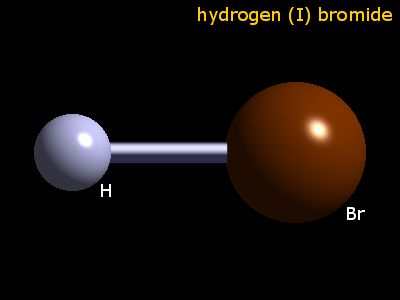Hydrogen bromide
- Formula: HBr
- Hill system formula: Br1H1
- CAS registry number: [10035-10-6]
- Formula weight: 80.912
- Class: bromide
- Colour: colourless
- Appearance: gas
- Melting point: -88.6°C
- Boiling point: -67°C
- Density: 2603 kg m-3 (liquid near freezing point); 3.55 kg m-3 (gas)
The following are some synonyms of hydrogen bromide:
- hydrogen bromide
- hydrogen(I) bromide
- hyrobromic acid
The oxidation number of hydrogen in hydrogen bromide is 1.
Synthesis
Hydrogen bromide gas can be made in the laboratory by the bromination of tetralin (1,2,3,4-tetrahydronapthalene). The downside is that half of the bromine is lost. The yield is about 94% (that is, 47% of the bromine ends up as HBr).
C10H12 + 4Br2 → C10H8Br4 + 4HBr
Hydrogen bromide gas may also be made in the laboratory by the reaction of concentrated sulphuric acid upon sodium bromide. However, a lot of the product is lost by oxidation with excess sulphuric acid to form bromine and sulphur dioxide.
NaBr(s) + H2SO4 → HBr(g) + NaHSO4(s)
Hydrogen bromide may be made in the laboratory by the reaction between purified hydrogen gas and bromine. This is catalyzed by platinized asbestos and carried out in a quartz tube at 250°C.
Br2 + H2 [Pt] → 2HBr
Solid state structure
- Geometry of hydrogen: 1 coordinate: terminus
- Prototypical structure:

Element analysis
The table shows element percentages for HBr (hydrogen bromide).
| Element | % |
|---|---|
| Br | 98.75 |
| H | 1.25 |
Isotope pattern for HBr
The chart below shows the calculated isotope pattern for the formula HBr with the most intense ion set to 100%.
References
The data on these compounds pages are assembled and adapted from the primary literature and several other sources including the following.
- R.T. Sanderson in Chemical Periodicity, Reinhold, New York, USA, 1960.
- N.N. Greenwood and A. Earnshaw in Chemistry of the Elements, 2nd edition, Butterworth, UK, 1997.
- F.A. Cotton, G. Wilkinson, C.A. Murillo, and M. Bochmann, in Advanced Inorganic Chemistry, John Wiley & Sons, 1999.
- A.F. Trotman-Dickenson, (ed.) in Comprehensive Inorganic Chemistry, Pergamon, Oxford, UK, 1973.
- R.W.G. Wyckoff, in Crystal Structures, volume 1, Interscience, John Wiley & Sons, 1963.
- A.R.West in Basic solid state chemistry Chemistry, John Wiley & Sons, 1999.
- A.F. Wells in Structural inorganic chemistry, 4th edition, Oxford, UK, 1975.
- J.D.H. Donnay, (ed.) in Crystal data determinative tables, ACA monograph number 5, American Crystallographic Association, USA, 1963.
- D.R. Lide, (ed.) in Chemical Rubber Company handbook of chemistry and physics, CRC Press, Boca Raton, Florida, USA, 77th edition, 1996.
- J.W. Mellor in A comprehensive treatise on inorganic and theoretical chemistry, volumes 1-16, Longmans, London, UK, 1922-1937.
- J.E. Macintyre (ed.) in Dictionary of inorganic compounds, volumes 1-3, Chapman & Hall, London, UK, 1992.
